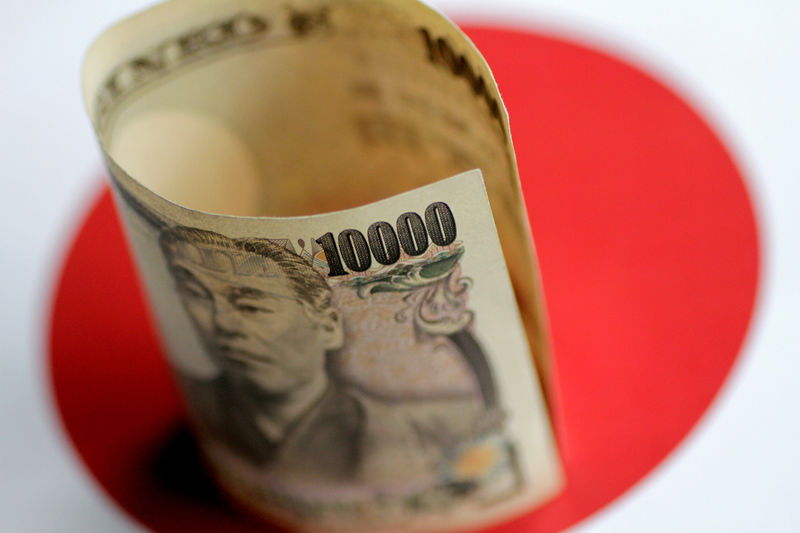 © Reuters. FILE PHOTO: Illustration photo of a Japan Yen note
© Reuters. FILE PHOTO: Illustration photo of a Japan Yen noteBy Swati Pandey
SYDNEY (Reuters) – BNP Paribas (PA:) calls it “the year of the yen”. Morgan Stanley (NYSE:) proclaims it’s the “land of the rising yen”. While, Citi has turned into a dollar bear with its latest report “we continue to holler – sell the dollar.”
Though most speculators have still to heed them, analysts are lining up to call a higher yen, expecting its traditional safe harbor status to draw investors made nervous by ballooning U.S. deficits and heightened financial market volatility.
A stronger yen, making imports cheaper, would undermine the Bank of Japan’s primary goal of increasing price growth to wrench the economy out of a long deflationary phase.
But analysts reckon the central bank may have run out of policy ammunition to resist the upward pull on the yen exerted by Japan’s improved economic growth and huge current account surplus.
“The Japanese yen can easily be the top performer among the G-10 currencies,” said Momtchil Pojarliev, deputy head of currencies at BNP Paribas Asset Management, referring to the Group of Ten advanced countries.
“The Bank of Japan (BoJ) remains dovish for now, but this means that the next policy shift can only be hawkish,” he added. “Second, the Japanese yen is one of the cheapest currencies in the world. Third, the return of financial market uncertainty is supportive for the Japanese yen.”
Yet currency speculators appear deaf to all the hollering, having built huge short positions in yen futures
Yen short positions remain about 40 percent larger than the past one-year average, and near levels seen in mid-2017.
The numbers are even larger if short yen positions held by Japanese retail investors – colloquially known as Mrs Watanabe – are taken into account.
Latest monthly data from the Financial Futures Association of Japan (FFAJ) showed that at the end of January, long positions in the dollar-yen trade held by retail currency traders were at 3.009 trillion yen ($28.09 billion).
That was the highest since January 2015 and more than three times the short positions at 922 billion yen.
If the analysts are right, it sets the scene for a massive shakeout that could see the yen test 100 per dollar or even higher.
‘LONG DOLLAR SHORT YEN’
This one-sided positioning has become a major risk for the greenback as a sustained rise in the yen would force investors to close out loss-making positions by buying yet more yen.
A similar unraveling happened in early 2016 when positions in the yen swung sharply from short to long, and the dollar followed by sinking from 120.00 yen to as low as 99.00.
The current short position in the yen is also much larger than back in 2016, even though more analysts are turning bullish toward the Japanese currency.
“This dissonance will eventually be resolved,” said Morgan Stanley analyst Hans Redekar who expects the dollar to ultimately succumb to twin deficit disease.
“We have to go back to the mid-1960s to find a similar situation, with the U.S. pursuing fiscal expansion despite labor market tightness, strong private sector investment, and widening foreign imbalances,” says Redekar.
“The result was the breakdown of Bretton Woods. Absent a fixed exchange rate regime, it should instead now lead to USD
weakness.”
DOVISH BOJ
Many analysts, including National Australia Bank, are predicting around 100-105 over the coming months. That could be a setback for Japan’s export-driven economy, and a downside risk for inflation.
It would also be a major challenge for the Bank of Japan with inflation still well short of its 2 percent target.
Governor Haruhiko Kuroda has gone out of his way to assure investors that policy will remain easy, a commitment underpinned by the government’s nomination of two dovish deputies.
History, however, shows the impact of BOJ policies on the currency market has become smaller with every new iteration.
For example, the yen fell for eight consecutive months on expectations of a radical easing in monetary policy when Shinzo Abe was elected prime minister in late 2012.
The yen resumed its slide in 2014 following the BOJ’s second round of quantitative easing and reached a 12-1/2-year trough in mid-2015.
But when the BoJ eventually announced its latest yield curve control (YCC) policy in September 2016, the yen’s decline was only modest and the currency has since recouped all that fall.
Just this month, investors practically ignored the news of the reappointment of Kuroda and his two new deputies amid doubts policy could be eased any further.
“Markets appear to be seeking clarity about whether the policy direction could really change under new members,” said Daiju Aoki, Chief Japan Economist at UBS Chief Investment Office Wealth Management.
“We expect no radical change of monetary policy from the current YCC. Market expectations for changing the regime or additional easing, if they surfaced, would not last long.”
GRAPHIC: http://reut.rs/2BSZHl2
GRAPHIC: http://reut.rs/2EWtGeY
Source: Investing.com



























